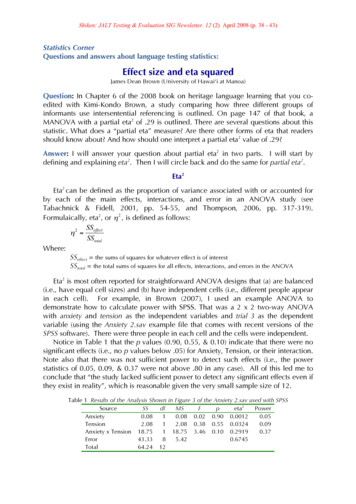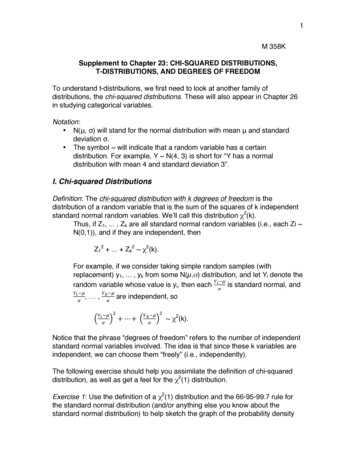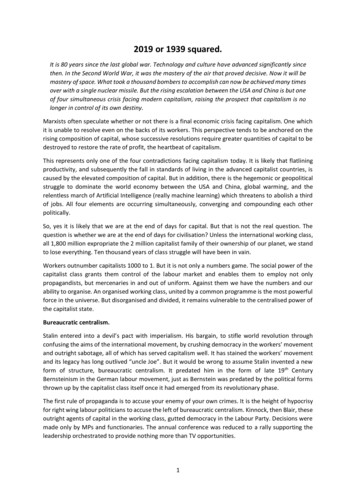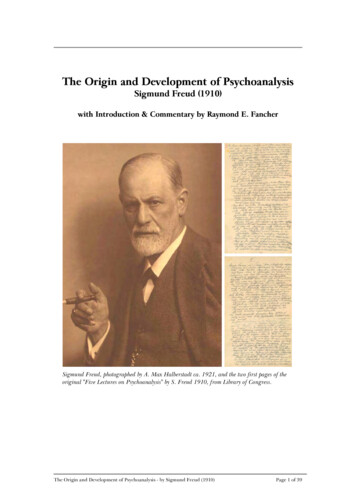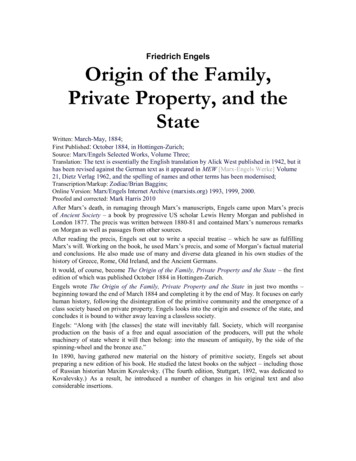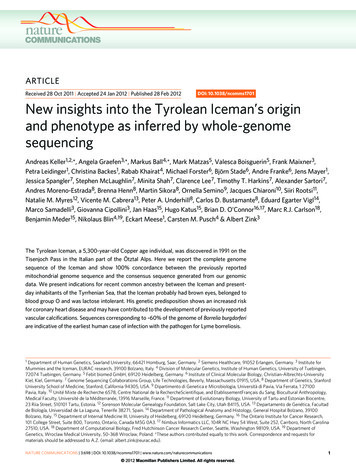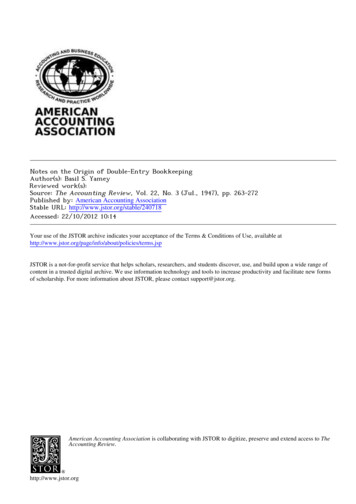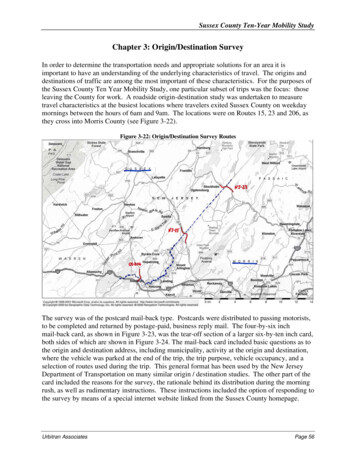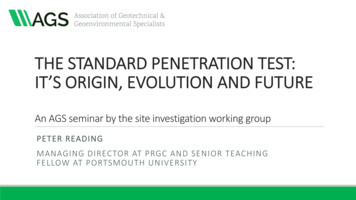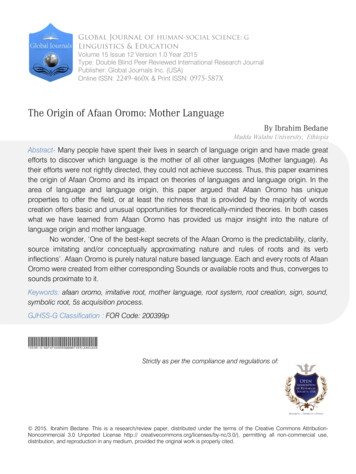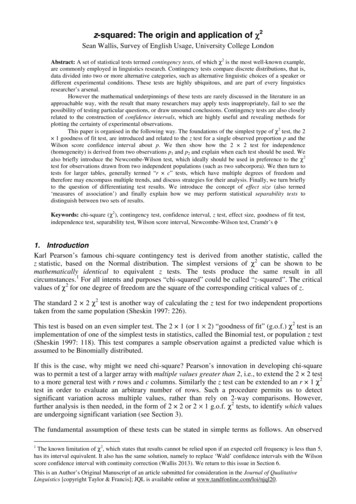
Transcription
z-squared: The origin and application of χ2Sean Wallis, Survey of English Usage, University College LondonAbstract: A set of statistical tests termed contingency tests, of which χ2 is the most well-known example,are commonly employed in linguistics research. Contingency tests compare discrete distributions, that is,data divided into two or more alternative categories, such as alternative linguistic choices of a speaker ordifferent experimental conditions. These tests are highly ubiquitous, and are part of every linguisticsresearcher’s arsenal.However the mathematical underpinnings of these tests are rarely discussed in the literature in anapproachable way, with the result that many researchers may apply tests inappropriately, fail to see thepossibility of testing particular questions, or draw unsound conclusions. Contingency tests are also closelyrelated to the construction of confidence intervals, which are highly useful and revealing methods forplotting the certainty of experimental observations.This paper is organised in the following way. The foundations of the simplest type of χ2 test, the 2 1 goodness of fit test, are introduced and related to the z test for a single observed proportion p and theWilson score confidence interval about p. We then show how the 2 2 test for independence(homogeneity) is derived from two observations p1 and p2 and explain when each test should be used. Wealso briefly introduce the Newcombe-Wilson test, which ideally should be used in preference to the χ2test for observations drawn from two independent populations (such as two subcorpora). We then turn totests for larger tables, generally termed “r c” tests, which have multiple degrees of freedom andtherefore may encompass multiple trends, and discuss strategies for their analysis. Finally, we turn brieflyto the question of differentiating test results. We introduce the concept of effect size (also termed‘measures of association’) and finally explain how we may perform statistical separability tests todistinguish between two sets of results.Keywords: chi-square (χ2), contingency test, confidence interval, z test, effect size, goodness of fit test,independence test, separability test, Wilson score interval, Newcombe-Wilson test, Cramér’s φ1. IntroductionKarl Pearson’s famous chi-square contingency test is derived from another statistic, called thez statistic, based on the Normal distribution. The simplest versions of χ2 can be shown to bemathematically identical to equivalent z tests. The tests produce the same result in allcircumstances.1 For all intents and purposes “chi-squared” could be called “z-squared”. The criticalvalues of χ2 for one degree of freedom are the square of the corresponding critical values of z.The standard 2 2 χ2 test is another way of calculating the z test for two independent proportionstaken from the same population (Sheskin 1997: 226).This test is based on an even simpler test. The 2 1 (or 1 2) “goodness of fit” (g.o.f.) χ2 test is animplementation of one of the simplest tests in statistics, called the Binomial test, or population z test(Sheskin 1997: 118). This test compares a sample observation against a predicted value which isassumed to be Binomially distributed.If this is the case, why might we need chi-square? Pearson’s innovation in developing chi-squarewas to permit a test of a larger array with multiple values greater than 2, i.e., to extend the 2 2 testto a more general test with r rows and c columns. Similarly the z test can be extended to an r 1 χ2test in order to evaluate an arbitrary number of rows. Such a procedure permits us to detectsignificant variation across multiple values, rather than rely on 2-way comparisons. However,further analysis is then needed, in the form of 2 2 or 2 1 g.o.f. χ2 tests, to identify which valuesare undergoing significant variation (see Section 3).The fundamental assumption of these tests can be stated in simple terms as follows. An observedThe known limitation of χ2, which states that results cannot be relied upon if an expected cell frequency is less than 5,has its interval equivalent. It also has the same solution, namely to replace ‘Wald’ confidence intervals with the Wilsonscore confidence interval with continuity correction (Wallis 2013). We return to this issue in Section 6.1This is an Author’s Original Manuscript of an article submitted for consideration in the Journal of QualitativeLinguistics [copyright Taylor & Francis]; JQL is available online at www.tandfonline.com/loi/njql20.
sample represents a limited selection from a much larger population. Were we to obtain multiplesamples we might get slightly different results. In reporting results, therefore, we need a measure oftheir reliability. Stating that a result is significant at a certain level of error (α 0.01, for example)is another way of stating that, were we to repeat the experiment many times, the likelihood ofobtaining a result other than that reported will be below this error level.2. The origin of χ22.1 Sampling assumptionsIn order to estimate this ‘reliability’ we need to make some mathematical assumptions about data inthe population and our sample.The concept of the ‘population’ is an ideal construct. An example population for corpus researchmight be “all texts sampled in the same way as the corpus”. In a lab experiment it might be “allparticipants given the same task under the same experimental conditions”. Generalisations from acorpus of English speech and writing, such as ICE-GB (Nelson et al 2002), would apply to “allsimilarly sampled texts in the same proportion of speech and writing” – not “all English sentencesfrom the same period” and so forth. Deductively rationalising beyond this population to a widerpopulation is possible – by arguing why this ‘operationalising’ population is, in the respect underconsideration, representative of this wider population – but it is not given by the statistical method.2.1.1 Randomness and independenceThe first assumption we need to make is that the sample is a random sample from the population,that is, each observation is taken from the population at random, and the selection of each memberof the sample is independent from the next. A classical analogy is taking a fixed number of mixedsingle-colour billiard balls (say, red or white) from a large bag of many balls.Where we are compelled to break this independence assumption by taking several cases from thesame text (common in corpus linguistics), at minimum we need to be aware of this and consider theeffect of clustering on their independence (see Nelson et al 2002: 273 and section 3.3). Ideally weshould be able to measure and factor out any such clustering effects. Currently methods for such‘case interaction’ estimation are work in progress.2.1.2 The sample is very small relative to the populationThe second assumption is that the population is much larger than the sample, potentially infinite. Ifthe sample was, say, half the size of a finite population ‘in the bag’, we would know that half thepopulation had the observed distribution of our sample, and therefore we should have a greaterconfidence in our estimate of the distribution of the entire population than otherwise. In suchcircumstances, using a z or χ2 test would tend to underestimate the reliability of our results. Inlinguistics this assumption is only broken when generalising from a large subset of the population –such as treating Shakespeare’s First Folio as a subset of his published plays.22.1.3 Repeated sampling obtains a Binomial distributionThe third assumption of these tests is perhaps the most complicated to explain. This is that repeatedsampling from the population of a frequency count will build up into a Binomial frequencydistribution centred on a particular point, and this distribution may be approximated by the Normaldistribution.Suppose we carry out a simple experiment as follows. We sample 45 cases over two Booleanvariables, A {a, a} and B {b, b}, and obtain the values {{20, 5}, {10, 10}} (Table 1). We————A standard adjustment is Singleton et al’s (1988) correction, multiplying the standard deviation by ν 1 – n/NP,where n/NP is the ratio of the sample to population size. If Np is infinite, ν 1.2z-squared: the origin and application of χ2-2-Sean Wallis
will take A as our independent variable, and B as ourdependent variable. This means that we try to see if Aaffects the value of B, schematically, A B.x̄ PFz.sThis kind of table might summarise the results of anexperiment measuring a speaker’s tendency to employ, say,modal shall rather than will in first person singular cases (sob stands for shall and b for will), in a spoken rather thanwritten English sample (a spoken, a written). For thisdiscussion we will use invented data to keep the arithmeticsimple.Next, imagine that we repeated our experiment, say, 1,000times, to obtain a ‘sample of samples’. The more repetitionswe undergo, the greater will be our confidence that theaverage result will be close to the ‘correct’ average (if wecould measure it) in the population. Sheskin (1997: 37)explains that “the standard error of the population meanrepresents a standard deviation of a sampling distribution ofmeans.” This ‘standard error of the population mean’ is alsoa theoretical value. The tests we discuss here estimate thisvalue from the standard deviation calculated from a singlesample.z.serrorerrorpFigure 1. Binomial approximationto a Normal frequency distributionplotted over a probabilistic rangep [0, 1].b bΣa201030 a51015Σ252045Table 1. An example 2 2contingency table.a aΣThe Binomial model states that the result for any single cell215b/3/3/9in our table will likely be distributed in a particular pattern124 b/3/3/9derived from combinatorial mathematics, called theBinomial distribution, centred on the population mean. This Table 2. Dividing by column totalspattern is represented by the columns in Figure 1.3 Therewrites Table 1 in terms offrequency axis, F, represents the number of times a value isprobabilities.predicted to have a particular outcome on the x axis,assuming that each sample is randomly drawn from the population.The Binomial distribution is a discrete distribution, that is, it can have particular integer values,hence the columns in Figure 1. Cell frequencies must be whole numbers. According to the CentralLimit Theorem this may be approximated to a continuous distribution: the Normal or ‘Gaussian’distribution, depicted by the curve in Figure 1.4 Note that in inferring this distribution we are notassuming that the linguistic sample is Normally distributed, but that very many samples are takenfrom the population, randomly and independently from each other.A Normal distribution can be specified by two parameters. The observed distribution O[x̄, s] has amean, x̄ (the centre point), and standard deviation, s (the degree of spread). The Normal distributionis symmetric, with the mean, median and mode coinciding.These distributions are sampling models, i.e. mathematical models of how future samples are likelyto be distributed, based on a single initial sample. The heart of inferential statistics is attempting topredicting how future experiments will behave, and our confidence that they will behave similarly3Suppose we toss a coin twice and count the number of heads, h. There are four possible outcomes: HH, HT, TH, TT.With an unbiased coin, the most likely value of h will be 1, because there are two ways to achieve this result. On theother hand the chance of h being 0 or 2 will each be ¼. We can summarise the expected distribution after fourrepetitions as F(h) {1, 2, 1}. We say that the variable h forms a Binomial distribution centred on the mean.4It is possible to calculate significance using only the Binomial distribution (Sheskin, 1997: 114) or Fisher’s 2 2 test(ibid. 221; see also Wallis forthcoming) – but these tests require combinatorial calculations which are onerous without acomputer. The Binomial approximation to the Normal has therefore traditionally proved attractive.z-squared: the origin and application of χ2-3-Sean Wallis
to our current experiment. We can now use the Normal distribution model to ‘peek into the future’and estimate the reliability of our single sample.2.2 The ‘Wald’ confidence intervalWe are going to approach our discussion of χ2 from the perspective of defining confidenceintervals. Approaching the problem this way makes it easier for us to visualise why χ2 is defined inthe way that it is – as an alternative calculation for estimating confidence and certainty – andtherefore what statistically significant results may mean.A confidence interval is the range of values that an observation is likely to hold given a particularprobability of error (say, α 0.05). This can also be expressed as a degree of confidence: ‘95%’.What we are interested in is how far an observation must deviate from the expected value to bedeemed to be statistically significantly different from it at a given error level (exactly as we wouldwith a χ2 test). Consider Figure 1. The area under the curve adds up to 100%. The two tail areasunder the curve marked “error” represent extreme values. Suppose we find the tail areas that eachcover 2.5% of the total area. We then have a range between them inside which 95%, or 1 in 20experimental runs, would fall. If we insist on a smaller error (α 0.01) then these tails must besmaller (0.005, or 0.5%) and the interval must be larger.Suppose that we performed an experiment and obtained the results in Table 1, {{20, 5}, {10, 10}}.Consider the first column, a {20, 10}, which in our experiment represents spoken data. Out of n 30 observations, 20 are of type b (shall) and 10, b (will). The probability of picking type b atrandom from this set is equal to the proportion of cases of type b, so p 2/3. The probability ofchoosing type b given a is the remaining probability, q 1 – p 1/3 (Table 2).The
z-squared: the origin and application of χ2 - 3 - Sean Wallis will take A as our independent variable, and B as our dependent variable. This means that we try to see if A affects the value of B, schematically, A B. This kind of table might summarise the results of an experiment measuring a speaker’s tendency to
